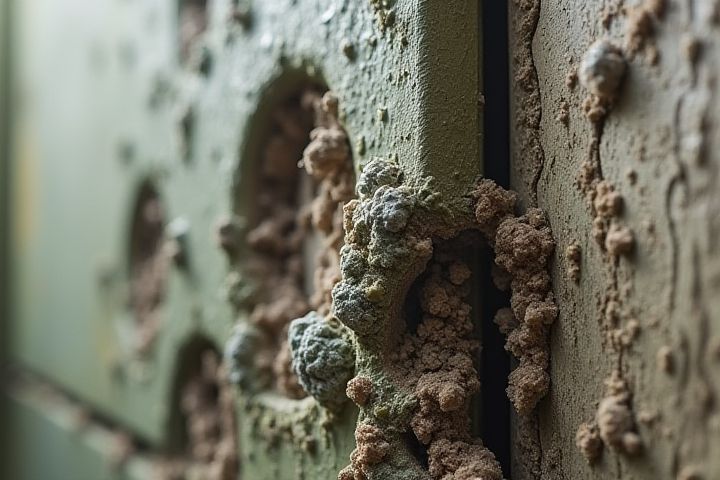
House mold can indeed be harmful to your health, particularly for individuals with respiratory issues, allergies, or weakened immune systems. Exposure to mold spores can trigger symptoms such as sneezing, coughing, and skin rashes, while prolonged exposure may lead to more severe respiratory problems or infections. Certain types of mold, such as black mold (Stachybotrys chartarum), produce mycotoxins that can cause toxic reactions in humans and pets. Maintaining proper humidity levels and ensuring adequate ventilation in your home can help prevent mold growth, protecting both your living space and your health. If you suspect mold presence, it's crucial to address the issue promptly to avoid potential health risks.
Can House Mold Be Harmful
Respiratory issues
House mold can significantly impact respiratory health, particularly for individuals with pre-existing conditions such as asthma or allergies. Exposure to mold spores can trigger symptoms like coughing, sneezing, and throat irritation, affecting approximately 10-30% of the population. In severe cases, prolonged exposure may lead to serious respiratory issues, including chronic obstructive pulmonary disease (COPD) or mold-related hypersensitivity pneumonitis. To mitigate these risks, it's essential to maintain indoor humidity levels below 50% and address any water leaks promptly.
Allergic reactions
House mold can trigger allergic reactions in sensitive individuals, leading to symptoms such as sneezing, runny or stuffy nose, and itchy eyes. Common types of mold, including Aspergillus, Cladosporium, and Penicillium, release spores that can become airborne and easily inhaled. Prolonged exposure to mold can exacerbate asthma and other respiratory conditions, particularly in children or those with compromised immune systems. To protect your health, it's essential to control moisture levels in your home and address any mold growth promptly.
Asthma triggers
House mold can significantly worsen asthma symptoms, acting as a potent trigger for many individuals. Common types of mold, such as Aspergillus and Penicillium, release spores into the air, which can be inhaled, leading to respiratory issues. In susceptible individuals, exposure to mold can cause inflammation in the airways, resulting in increased coughing, wheezing, and shortness of breath. Ensuring proper ventilation and humidity control in your home can help mitigate the growth of mold and create a healthier living environment.
Mycotoxin exposure
House mold can pose significant health risks, particularly through mycotoxin exposure. Mycotoxins are toxic compounds produced by certain mold species, which can lead to respiratory issues, allergic reactions, and long-term health problems in susceptible individuals. Common molds like Aspergillus, Penicillium, and Stachybotrys (black mold) are known to produce harmful mycotoxins that can proliferate in damp or poorly ventilated areas of your home. To minimize exposure, it's crucial to maintain proper humidity levels, ensure adequate ventilation, and promptly address any water leaks or mold growth.
Weakened immune system
House mold can pose significant health risks, especially for individuals with a weakened immune system. Exposure to mold spores can trigger allergic reactions, respiratory issues, and infections in susceptible individuals. According to the Centers for Disease Control and Prevention (CDC), approximately 2 to 10% of the population may develop health problems from mold exposure. If you have a compromised immune system, it's crucial to address any mold infestations promptly to mitigate potential health complications.
Structural damage
House mold poses significant risks not only to health but also to the structural integrity of your home. Mold can thrive in damp areas, leading to wood rot, weakened beams, and compromised drywall. This degradation may cause costly repairs and necessitate extensive remediation efforts. To protect your property and prevent structural damage, it's essential to address moisture issues promptly and maintain proper ventilation in susceptible areas.
Hidden growth
Hidden mold growth in your house can pose significant health risks, often without obvious signs like visible stains or a musty odor. Mold thrives in damp and poorly ventilated areas, such as behind walls, under floors, and in attics, making it easy to overlook. Exposure to mold spores can lead to allergic reactions, respiratory issues, and other health problems, especially for sensitive individuals. To protect your well-being, regular inspections and proper moisture control are crucial in preventing hidden mold growth.
Increased humidity
Increased humidity can create an ideal environment for mold growth in homes, leading to potential health risks for occupants. Mold spores thrive in damp conditions, often found in areas like basements, bathrooms, and kitchens. Exposure to mold can trigger allergic reactions, respiratory issues, and other health problems, particularly in individuals with asthma or weakened immune systems. To mitigate these risks, it's essential to control indoor humidity levels by using dehumidifiers, ensuring proper ventilation, and addressing any leaks promptly.
Health risk to pets
House mold presents significant health risks to pets, often manifesting in respiratory issues, skin irritations, and allergic reactions. Species like dogs and cats can experience symptoms such as coughing, sneezing, and excessive scratching when exposed to mold spores. In severe cases, prolonged exposure might lead to more serious conditions, including asthma or infections, particularly in pets with compromised immune systems. Ensuring your home is free from mold not only protects your furry friends but also contributes to a healthier living environment overall.
Children vulnerability
House mold poses significant health risks, particularly for children, whose developing respiratory systems make them more vulnerable to allergens and toxins. Exposure to mold can lead to symptoms such as coughing, wheezing, and allergic reactions, with studies indicating that children living in mold-damaged homes are 50% more likely to develop asthma. According to the Centers for Disease Control and Prevention (CDC), indoor mold exposure can also exacerbate conditions like chronic nasal congestion and skin irritation in young ones. Keeping humidity levels below 50% and ensuring proper ventilation in your home are essential steps to mitigate mold growth and protect your child's health.
